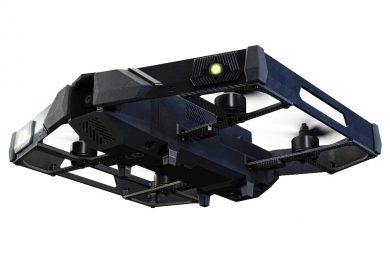DSA 2024 – Pen Aviation unveils its PEN35 UAS in electric and hybrid configurations
At DSA 2024 Pen Aviation unveiled the last member of its family of fixed-wing and rotary-wing unmanned aerial systems, the PEN35, proposed in both all-electric and hybrid versions. AI-based software by its French spinoff DGMIND was also visible
A Malaysian company founded in 2016, specialised in customised solutions within the aviation market, in 2019 Pen Aviation started design and produce UAS under the Pen UAS brand. Until now the company portfolio included two rotary wing models, the PEN 55Vone fixed wing model, a 55 kg maximum take-off mass helicopter like aircraft with a 15 kg payload, and the much bigger PEN 1360, here too the name showing the mass at take-off, payload being 770 kg at full fuel, while one fixed wing with VTOL capability, the PEN 23, is declined in two models, VE and VH respectively with electric and hybrid propulsion, and maximum mass of 23 kg. The Pen 23 has already bagged an order from a military customer, which the company declined to mention.
Two propulsion systems are proposed also for the new member of the PEN family, the PEN 35, which maximum take-off mass is clearly 35 kg. The PEN 35 architecture is very similar to that of the PEN 23, with an aerodynamic fuselage, high wing made of carbon fibre and fibre glass, and double tail boom. The tail plane is however different, the smaller airframe having a sort of inverted-V structure while the PEN 35 has a horizontal plane with vertical rudders. The powerplant providing the forward push when the aircraft flies aerodynamically is located at the rear of the fuselage and powers a two-blade propeller; under each of the booms, which protrude in front of the wing, we find two rotors each powered by an electric motor, the four of them ensuring sufficient lift for take-off and landing. A four-leg landing gear ensures sufficient stand-off from the ground to keep rotors away from ground and provide adequate stand-off to possible optronic payloads, the prototype exhibited at DSA being in full clean configuration.
The PEN 35 is 2,360 mm long, 700 mm high, and has a 3,920 mm wingspan. It carries an 8 kg useful payload and can fly at a maximum speed of 140 km/h, a cruise speed between 90 and 125 km/h, and up to an altitude of 5,000 metres. Endurance obviously varies between the VE electric and the VH hybrid configurations; the former is 3.5 hours while the latter, which includes a thermal engine for forward propulsion, reaches up to 8 hours. It can also be fitted with a 400 W alternator to cope with power-hungry payloads. Standard data link ensures a 40 km operational range, however a 100 km range can be obtained using a different link.
The PEN 35 mobile ground control station has a mass of 25 kg, with dimensions of 1,199x419x234 mm. It is designed to reduce as much as possible the human workload, all functions including take-off and landing being automated. The PEN 35 is SAIL II certified thanks to its redundant system architecture and can thus fly beyond line of sight. enabling BVLOS. Four levels of data transfer system (DTS) are available, the primary one being RF-based with frequencies selectable by customers to comply with local requirements, a backup DTS based on SATCOM, an RF-based emergency DTS working on 868 MHz or 433 MHz, and finally a safety DTS working on 2.4 GHz, the latter being optional. The PEN 35 is fitted with a flight termination system with a safety parachute.
The PEN 35 is proposed for intelligence, surveillance and reconnaissance missions, search and rescue, security, mapping, or cargo delivery. It can be equipped with several types of electro-optic gimballed sensor suites. DGMIND SAS France, a spin-off of Pen Aviation specialised in digital solutions aimed automating UAS operational processes, provides the ADATMMA module (Automatic Detection And Tracking of Multiple Moving Assets) that allows the detection and tracking of multiple targets at the same time together with real time geotagging. Three different AI-based ADATMMA packages are available, respectively for land, maritime and search and rescue missions. The PEN 35 can be fitted with a phone localiser, a loudspeaker, auto-inflatable floats, and other types of payloads.
The PEN 35 has already undergone company flight tests and is considered at TRL 7/8.
In the same stand the aforementioned DGMIND SAS France, exhibited an Artificial Intelligence-based software that allows dramatically reducing post-flight video analysis workload. The operator types in the target he or she is looking for, for example a certain type of armoured vehicle, and the software finds all the video sequences that show this type of vehicle. According to the company this software is already used by Singapore military and police entities (the picture showing a search for the Malaysian flag).
Last but not least, at DSA Pen Avionics inked a Memorandum of Understanding with Safran Electronics and Defense. Through this strategic alliance, both entities will be able to define elements of workshare for the integration of Safran Euroflir 410 Airborne Optronic Systems on PEN UAS systems, including the PEN1360V, and explore mutually beneficial opportunities of cooperation.
Photos by P. Valpolini




